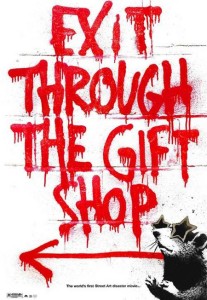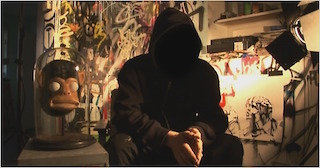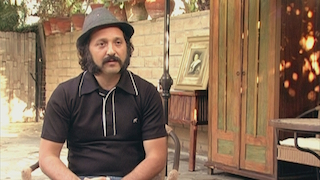 If you grew up in a big city or metro area, like I did in the Milwaukee metro, graffiti and graffiti art was an ubiquitous part of the urban landscape. Even when I lived in Stevens Point, Wisconsin, about as far as you can get from urbanization, graffiti was all over the train cars that pulled into the Canadian National junction where Tina and I lived when we were first married. I always wondered exactly how such incredibly beautiful, yet sometimes vulgar and tasteless, paintings got on some of the places they were, or how they managed to even pull it off. In the late 90’s, graffiti took on new forms of artistic expression and political subversiveness in the underground art form, street art. Utilizing global cities and the new internet age to document and show their art, street artists around the world became the the cool, underground counter-culture for millennials, much like skaters had been that for Generation X-ers.
If you grew up in a big city or metro area, like I did in the Milwaukee metro, graffiti and graffiti art was an ubiquitous part of the urban landscape. Even when I lived in Stevens Point, Wisconsin, about as far as you can get from urbanization, graffiti was all over the train cars that pulled into the Canadian National junction where Tina and I lived when we were first married. I always wondered exactly how such incredibly beautiful, yet sometimes vulgar and tasteless, paintings got on some of the places they were, or how they managed to even pull it off. In the late 90’s, graffiti took on new forms of artistic expression and political subversiveness in the underground art form, street art. Utilizing global cities and the new internet age to document and show their art, street artists around the world became the the cool, underground counter-culture for millennials, much like skaters had been that for Generation X-ers.
Exit Through The Gift Shop is an unwitting documentary narrative directed by the most famous of these street artists, the anonymous Englishman, Banksy. It is unwitting in that the subject of the documentary, and confessed to being the real subject of the documentary by Banksy himself, Thierry Guetta, had no intention of making a documentary when he first started filming the street art scene. As the movie opens, Guetta is a French emigre living in a bohemian neighborhood of LA and owns a vintage clothing shop. Whether because of a compulsive need to have his life fully documented or a result of early childhood loss that led him to make sure he and his kids did not miss a moment, Guetta has an ever present handheld camera that he uses to film his life. Sporting a somewhat goofy, Civil-war era style facial hair, Guetta’s constant camera work goes unnoticed by his family members. This documentary takes the unwitting turn when he visits his cousin in France and comes to find that his cousin is the well-known underground street artist, Invader. Guetta, never one to turn down a new adventure, heads out into the Parisian nights as his cousin and his friends “invade” the streets with his brand of 8-pixel street art.
Guetta personality, one of goofiness, risk-taking, and a comical aloofness to danger and his own surroundings, is the perfect fit to document the street artist movement. You see Theirry climb even higher up on dangerous roofs and out on ledges to capture shots and is just as daring as the street artists, if not more so. At times, especially in the final third, it’s hard to believe Guetta’s cartoonish and over-the-top nature can even be real.
In fact, the movie has this undercurrent of psuedo-reality that, at times, makes it seem like a mockumentary. What makes the movie so fascinating is this tenuous relationship the movie has with the documentation of street art and the comical and Looney Toons moments. When it first came out in 2010, it was widely believed and hyped as being the very first “prankumentary”, all staged by Shepard Fairy, another renowned street artist Guetta made friends with, and the previously mentioned director and artist, Banksy. The first two thirds don’t seem that much like a prank, but as stated earlier, the final third goes a little goofy (and genius) and embraces the prank label. Is it real? It is fake? If so, is it art?
That’s the final question Banksy asks when confronted with the outlandish final third of this movie. He is not referring the meta-narrative of a “prankumentary” but what happened on screen. But his question remains. Movies, just like and as art, show what real life means. So is an elaborate movie prank, even if perpetrated by a subversive figure like Banksy, considered art?
 At the heart of Exit Through the Gift Shop is this documentation of the subversive nature of street art and its tenuous relationship with the world of “serious” art and also its subsequent breakout into that world. The movie wrestles with the legitimacy that has been given to this underground artistic medium, but at what cost? When someone copies that or mimics the art form for commercialization, is it hailed as a victory for that artistic medium? Is it a selling out for a quick payday? Or can true genius be a hyped and commercial enterprise? It’s all questions we don’t get answers to but are left to be debated and pondered. If beauty is in the eye of the beholder, can we discredit the beauty or the beholder?
At the heart of Exit Through the Gift Shop is this documentation of the subversive nature of street art and its tenuous relationship with the world of “serious” art and also its subsequent breakout into that world. The movie wrestles with the legitimacy that has been given to this underground artistic medium, but at what cost? When someone copies that or mimics the art form for commercialization, is it hailed as a victory for that artistic medium? Is it a selling out for a quick payday? Or can true genius be a hyped and commercial enterprise? It’s all questions we don’t get answers to but are left to be debated and pondered. If beauty is in the eye of the beholder, can we discredit the beauty or the beholder?


